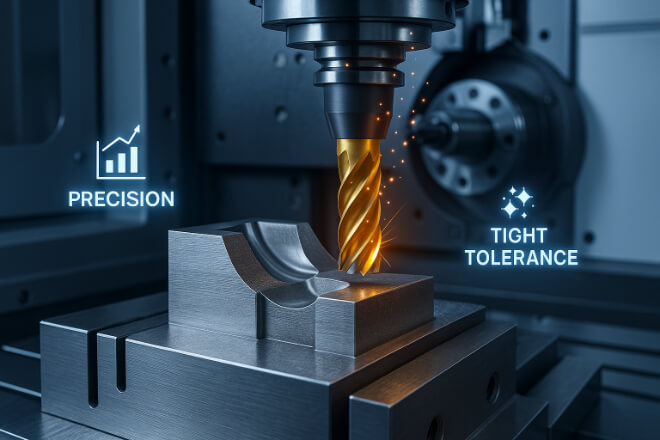텅스텐 카바이드 절삭 공구 다음과 같은 산업에서 신뢰받습니다. 항공우주, 자동차, 금형 제작, 그리고 정밀 가공. 그들의 힘, 내마모성, 그리고 절삭 속도가 필수적이기 때문입니다.
하지만 코팅되지 않은 버전과 코팅된 버전 중 하나를 선택해야 할 때, 기계 가공 사업의 많은 의사결정권자들은 확신을 갖지 못하는 경우가 많습니다.
이 가이드에서는 코팅되지 않은 텅스텐 카바이드 절삭 공구와 코팅된 텅스텐 카바이드 절삭 공구의 실제 차이점을 쉽게 설명합니다.
코팅이 도구 수명, 성능, 비용에 어떤 영향을 미치는지 알려드리겠습니다. 이를 통해 작업에 맞는 올바른 결정을 내릴 수 있습니다.
코팅되지 않은 텅스텐 카바이드 공구란 무엇인가?
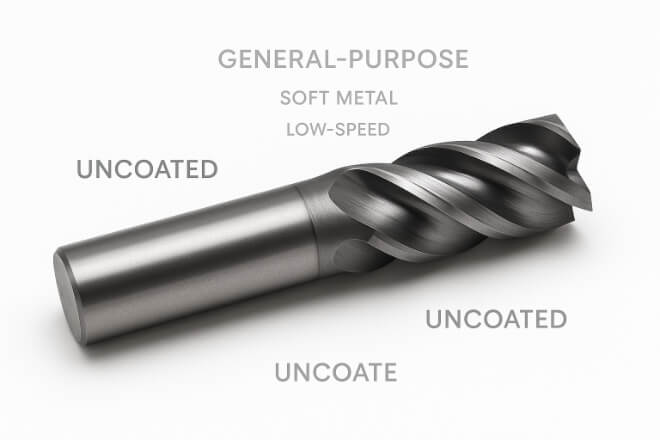
코팅되지 않은 텅스텐 카바이드 공구는 표면 처리 없이 단단한 텅스텐 카바이드 소재로 제작됩니다.
그들은 높은 것을 제공합니다 경도 수준이고 열과 마모가 관리 가능한 분야에서 널리 사용됩니다.
이러한 도구는 일반적으로 다음에서 사용됩니다.
일반용 가공
저속 절단 작업
열을 많이 발생시키지 않는 재료(플라스틱이나 연성 금속 등)
초기 비용은 저렴하지만, 단단한 재료를 절단하거나 고속으로 작동하면 더 빨리 마모됩니다.
코팅된 텅스텐 카바이드 공구란 무엇인가?
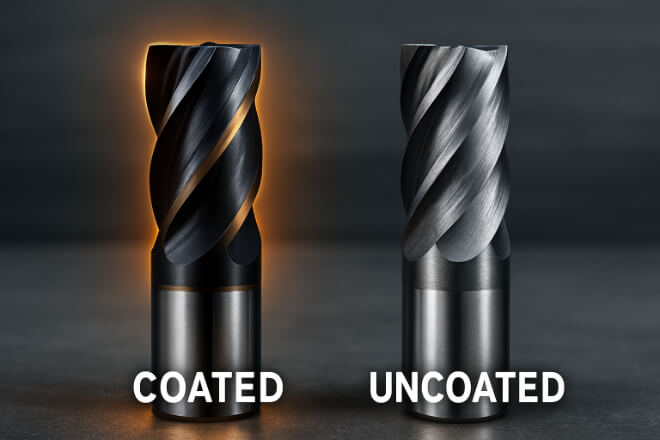
코팅된 텅스텐 카바이드 공구는 텅스텐 카바이드 모재 위에 단단하고 얇은 코팅층을 추가합니다. 이 코팅은 공구를 보호하고 절삭 성능을 향상시킵니다.
일반적인 코팅은 다음과 같습니다.
TiN(질화티타늄) – 경도를 향상시키고 마찰을 줄입니다.
TiAlN(티타늄 알루미늄 질화물) – 높은 열을 처리합니다.
AlTiN – 산화 저항성 향상
DLC(다이아몬드 유사 탄소) – 비철 및 연마재에 적합
이러한 코팅은 일반적으로 물리적 기상 증착(PVD)이나 화학적 기상 증착(CVD) 공정을 통해 적용됩니다.
코팅된 도구는 다음과 같은 경우에 적합합니다.
고속 가공
스테인리스 스틸이나 주철과 같은 단단한 재료
공구 마모 감소 및 공구 수명 연장
코팅되지 않은 텅스텐 카바이드 공구와 코팅된 텅스텐 카바이드 공구의 주요 차이점
이 두 도구 유형을 비교해보면 다음과 같습니다.
| 특징 | 코팅되지 않은 도구 | 코팅 도구 |
|---|---|---|
| 표면 보호 | 추가 보호 없음 | 단단한 코팅층은 마모에 강합니다. |
| 내열성 | 낮추다 | 더 높은 – 극한의 온도를 견딥니다 |
| 공구 수명 | 더 짧은 | 마모 감소로 인해 더 길어짐 |
| 마찰 및 칩 흐름 | 더 높은 마찰 | 마찰 감소로 칩 제거가 향상됩니다. |
| 이상적인 응용 프로그램 | 연성 소재, 저속 작업 | 경질 소재, 고속 가공 |
| 비용 | 앞쪽 낮은 | 선불금이 높을수록 ROI가 더 좋습니다. |
코팅된 텅스텐 카바이드 공구 사용의 장점
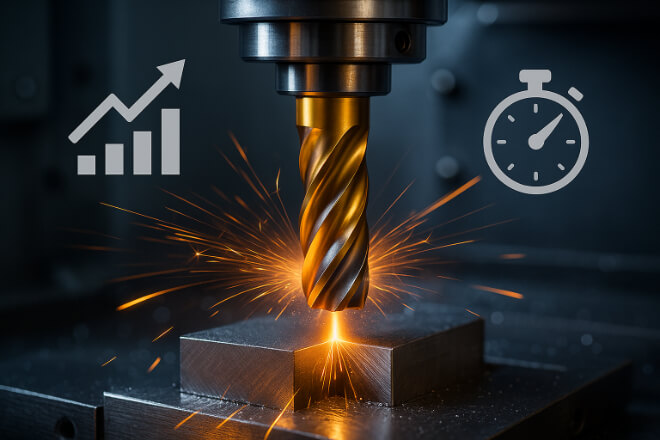
코팅이 산업 기계 가공의 성능을 크게 향상시킬 수 있는 이유를 알아보겠습니다.
- 더 긴 공구 수명
코팅은 마치 갑옷과 같은 역할을 합니다. 공구 마모를 줄이고, 날의 라운딩을 지연시키며, 특히 단단한 금속을 가공할 때 내구성을 향상시킵니다.
- 더 높은 속도와 이송
코팅된 공구는 열에 더 잘 견디므로 절삭 속도를 높이고 이송 속도를 높여 생산성을 향상시킵니다.
- 더 나은 표면 마감
코팅된 도구는 마찰을 줄여 표면을 더 매끄럽게 하고 허용 오차를 줄입니다.
- 다운타임 감소
공구 수명이 길어지면 공구 교체 횟수가 줄어들어 기계 가동 중단 시간을 줄이는 데 도움이 됩니다.
- 부품당 총 비용 절감
코팅된 도구는 처음에는 비용이 더 많이 들 수 있지만, 시간이 지남에 따라 더 나은 결과를 제공합니다. 따라서 장기 생산 시 비용 효율적입니다.
코팅되지 않은 도구는 언제 사용해야 할까?
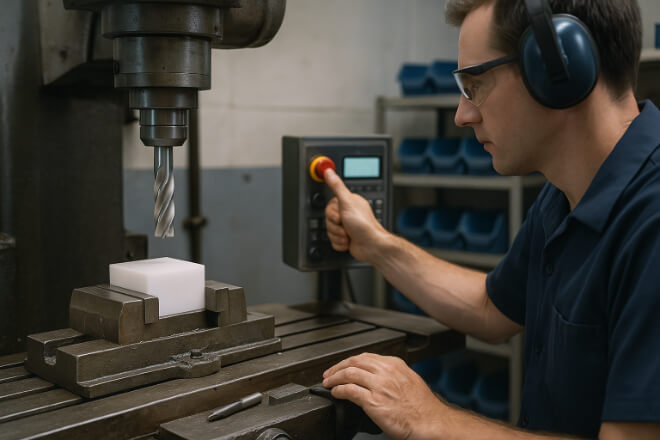
코팅된 도구에는 장점이 있지만 코팅되지 않은 도구가 더 적합한 경우도 있습니다.
플라스틱, 황동 또는 알루미늄과 같은 연성 소재를 가공하고 있습니다.
예산이 부족하고 높은 생산 속도가 필요하지 않습니다.
귀하의 작업은 더 느린 스핀들 속도와 더 간단한 기계를 사용합니다.
당신은 쉽게 다시 날을 세우는 것을 선호합니다(일부 코팅은 이것을 어렵게 만듭니다)
코팅되지 않은 도구는 재연마하기가 더 쉽고 프로토타입 제작, 소량 생산 또는 일반 용도 작업에 적합할 수 있습니다.
귀하의 응용 분야에 적합한 코팅 선택
각 코팅은 고유한 장점을 제공합니다. 간단한 가이드를 소개합니다.
| 코팅 유형 | 가장 적합한 | 주요 장점 |
|---|---|---|
| 주석 | 일반용, 강철, 주철 | 마모와 마찰을 줄입니다 |
| TiAlN / AlTiN | 스테인리스 스틸과 같은 고온 금속 | 열과 산화에 강함 |
| 다운로드 가능 콘텐츠 | 알루미늄, 구리, 플라스틱 | 물질 축적을 방지합니다 |
| CVD 다이아몬드 | 탄소섬유, 세라믹 | 극한의 경도와 내마모성 |
마무리 생각: 어느 것이 더 낫나요?
정답은 단 하나뿐입니다. "더 나은" 도구는 무엇을 자르는지, 얼마나 빨리 작업해야 하는지, 그리고 어떤 품질을 기대하는지에 따라 달라집니다.
하지만 현대의 여러 가공 분야에서 코팅된 텅스텐 카바이드 절삭 공구는 분명한 이점을 제공합니다. 초기 비용이 조금 더 들더라도, 수명이 더 길고 성능이 뛰어나며 전체 비용을 절감해 줍니다.
정밀함과 내구성을 갖춘 도구를 원하시나요? 방문하세요 레톱즈 전 세계 제조업체로부터 신뢰를 받고 있는 코팅 및 비코팅 카바이드 절삭 공구 제품군을 살펴보세요.

